 No fooling here. On April 1, 1985 Villanova upset Georgetown, 66-64 in the 1985 NCAA title game as three Big East teams made the Final Four that year
No fooling here. On April 1, 1985 Villanova upset Georgetown, 66-64 in the 1985 NCAA title game as three Big East teams made the Final Four that yearKentucky, Alabama and LSU were all sent to the Southeast Regional in 1986. Auburn was sent to the West Regional. In the second year of the tournament having expanded to 64 teams and four rounds to make it to the Final Four, there were still some issues that needed modifying.Every season since the tournament started to 'open up' in 1975, something would pop up that would eventually get corrected. Through the 1986 tournament the NCAA merely 'suggested' or 'allowed' teams from one conference to be sent to different regionals,but it wasn't a 'rule'.
Nonetheless, the 1986 SEC season was one of the wildest seasons as four SEC teams advanced to the Sweet 16 with three making it to the Elite Eight and one making it to the Final Four.Kentucky ,under new coach Eddie Sutton, won the SEC with shocking ease with a 17-1 conference mark. After Tulane's departure from the SEC following the 1966 season, the SEC adopted an 18 game 'round robin' format where each team would play every conference member twice, home and home . This format lasted through the 1991 season as the league split into divisions with the inclusion of South Carolina and Arkansas. The '86 Wildcats 17-1 league mark tied Kentucky's own record in the 1969-1970 season and LSU in the 1980-1981 season for best league record . One of Kentucky's wins was a 62-60 win over Tennessee in Knoxville. In Sutton's first season, he already had as many wins in Knoxville as his predecessor, Joe B. Hall did in thirteen seasons.
 After telling anyone who would listen in March of '85 that he'd "crawl to Lexington", Eddie Sutton hit the ground running in 1986 with a 17-1 SEC mark and Conference and Tournament title and #1 seed in the Southeast
After telling anyone who would listen in March of '85 that he'd "crawl to Lexington", Eddie Sutton hit the ground running in 1986 with a 17-1 SEC mark and Conference and Tournament title and #1 seed in the SoutheastThe lone conference loss was to Auburn, 60-56 in the second game of the conference season. The game originally was to have been both school's opening conference game but was moved from Thursday Jan 2 to Monday Jan 6 as Kentucky accommodated Auburn's request to move the game due to Auburn's football team's participation in the Cotton Bowl on New Year's Day. Auburn's improbable SEC tournament win in 1985 and advancement to the Sweet 16 invigorated Auburn's program and fanbase to levels it had not ever seen,but football was still king and Auburn's athletic family would still be returning from Dallas as would a portion of its fan base and the Tigers wanted as many fans as possible to face the venerable Wildcats. The move paid off as a sell out crowd of nearly 12,000 helped pull the Tigers through.
 Kentucky agreed to Auburn's request to move their home game back a few days to let fans,students and administrators return back home after the Cotton Bowl. Auburn wasn't as receptive to LSU's request a few weeks later to postpone another home game
Kentucky agreed to Auburn's request to move their home game back a few days to let fans,students and administrators return back home after the Cotton Bowl. Auburn wasn't as receptive to LSU's request a few weeks later to postpone another home gameAuburn started off the season ranked 10th in the nation but lost its season opener to West Virginia in the inaugural preseason NIT and dropped out of the rankings for good. The Tigers did defeat the same Mountaineer squad ten days later and entered league play with a 6-4 non conference mark which included two losses to Sunbelt teams, Western Kentucky and UAB who would each make the 1985-86 NCAA tournament. Auburn would go on to a 13-5 league mark good enough for second place and the second seed in the 1986 SEC tournament at Kentucky's old Kentucky Home at Rupp Arena in Lexington.
Alabama tied Auburn for second with a 13-5 mark,but lost on the tie breaker due to having lost both games to champion Kentucky in the regular season while Auburn split with the 'Cats. The Tide came into the SEC tournament with an overall 20-7 record having been ranked in the top 20 twice during the season.
LSU came into the SEC Tournament with a 21-10 overall mark and 9-9 SEC mark tied for fifth with Georgia one game behind Florida, whom the Bengal Tigers would face in the second round of the SEC tournament. LSU, who won the SEC regular season title the year before, had one of the strangest seasons in SEC history.

This November 1985 SI Cover was just the start of a crazy season for the 1985-1986 LSU Tigers
The Tigers started off the season 14-0 rising as high as eight in the polls. Even the unbeaten start wasn't without controversy. After Jerry Reynolds left with one season of eligibility left, the Tigers briefly had highly sought after Tito Horford after Horford briefly enrolled at Houston. Dale Brown dismissed Horford who left for Miami (Fla) which was reviving its program after a fourteen year hiatus. Then at the end of the fall semester LSU ruled power forward Nikita Wilson academically ineligible for the Spring Semester.
After the 14-0 start,LSU suffered back to back road losses to Alabama and Tennessee. After two easy home wins over Vanderbilt and Ole Miss, the Tigers lost in Gainesville to Florida. In the aftermath of the Florida loss, LSU really suffered.Upon returning to Baton Rouge, center Ricky Blanton came down with chicken pox. Then star forward John "Hot Plate" Williams and Bernard Woodside came down with cases so severe they were hospitalized for a week. Obviously, chicken pox is more associated with young children. But it can be a more serious illness for adults. Therefore team doctors quarantined ten other players for observation.
This caused LSU to reschedule its next game. Coincidentally, the next game was against Auburn ,who had rescheduled its first conference game of the season with Kentucky due to the majority of its athletic administration returning from Dallas from the Cotton Bowl in addition to students and other fans. Whereas Auburn had asked Kentucky to move that game, Auburn wasn't very accommodating initially to LSU's request. LSU did have four players that had been cleared to play and Auburn and some of the Alabama media felt LSU should send those four and scrape up some intramural players and show up in Auburn. The LSU game in Auburn was to be Auburn's first ever home game on National television.But, the proverbial cooler heads prevailed and the two rescheduled ten days later.
LSU's first game back after the chicken pox bout was at home against #8 Kentucky. Playing with Williams and Woodside, LSU gave it a valiant try, but UK senior Roger Harden nailed a 20 footer at the buzzer for a 54-52 Kentucky win. LSU then went on to play four road games in five days losing at Georgia and Georgetown while defeating Auburn in the makeup game and winning in Starkville.
As the SEC tournament started, regular season champion Kentucky, Auburn and Alabama were virtual locks. The 4-5 game between Florida and LSU was viewed by some as a "play-in" game with the winner of that game surely enhancing its NCAA hopes with the loser all but eliminating itself. Norm Sloan's Gators were in a similar spot the prior year matched up with Kentucky in what looked like a play-in game in Birmingham in 1985. Florida pulled out a 58-55 win,but it was Kentucky that received a bid. LSU was in the midst of a ten game losing streak in post season play dating back to the 1981 Final Four.LSU had gone 0-4 in its last 4 SEC tourney games and had also lost two home games in the NIT and two NCAA first round games during this streak.
In one of the biggest wins in Brown's career, LSU defeated Florida 72-66 to send the Tigers into the SEC semifinals vs Kentucky, an easy winner over Ole Miss.The Gators,hoping for their first ever NCAA bid,would have to wait one more year. Alabama blew out a decent Georgia team, 79-59 who had had a slim shot at the NCAA's and first round winner Mississippi State upset two seed Auburn pitting the Tide and Bulldogs in the other semifinal, as the two met in the SEC tournament for the third time in four years. Alabama won 77-65 ending Bob Boyd's tenure in Starkville after a five year career. Boyd, who had a tremendous career in Los Angeles at Southern California from 1967-1979, had the misfortune of not just being in the same conference with college basketball's greatest coach,but the same town. His Trojan teams in 1969 and 1970 gave UCLA its first losses in Pauley Pavilion and the 1971 squad finished 5th in the nation and the '74 team won 24 games. Unfortunately this was when only one team from a conference could go to the NCAA tourney. In 1971, UCLA won the National Title; in 1974 UCLA finished 3rd in the nation losing in the Final Four to champion NC State, coached by Norm Sloan. Still, Boyd's Bulldog teams struggled with only one (1982-1983) team having a winning record.

Norm Sloan, in his second stint with Florida, won the National Title with NC State in 1974 but would have to wait one more year to take the Gators to their first ever NCAA tourney
The nightcap would be between LSU and Kentucky for the third time this season. In addition to the 54-52 win in Lexington, Kentucky won at home on "Senior Day", 68-57 where former Kentucky Lt. Governor, Governor ,Senator and MLB Commissioner Albert Benjamin "Happy" Chandler sang "My Old Kentucky Home" for one final crowd to the misty eyed Rupp Arena faithful.
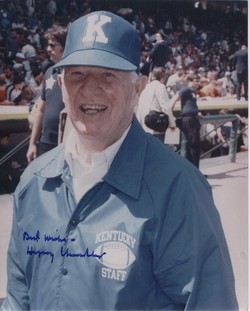 Lad(ies) and Gentlemen couldn't help but weep when former Gov. Happy Chandler sang "My Old Kentucky Home" on Senior Day at Rupp Arena
Lad(ies) and Gentlemen couldn't help but weep when former Gov. Happy Chandler sang "My Old Kentucky Home" on Senior Day at Rupp ArenaRound three for LSU and Kentucky was another battle. LSU led by one at halftime and 56-51 with a little over two minutes left. Kentucky ended the game on a 10-2 run aided by another dagger by Roger Harden,this time with UK having regained the lead 59-58 with :10 and the shot clock about to expire , he nailed a jumper to put Kentucky up 61-58 in the season before the three point shot effectively putting the game out of reach as that score was the final.
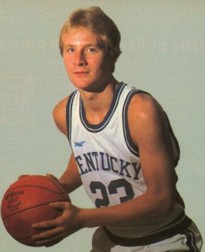 Roger Harden broke LSU's heart twice in 1986 with two buzzer beaters
Roger Harden broke LSU's heart twice in 1986 with two buzzer beatersAlabama's win over Mississippi State put the Tide in the SEC tournament final for the fourth time in five years. Alabama and Kentucky had faced one another in the championship game in 1982,the last time the tourney was in Lexington. After losing both regular season game to Kentucky, Alabama won the title game, 48-46. Like in 1982, Alabama lost both regular season games in 1986 to Kentucky. The one in Lexington was a UK rout 76-52, the game in Tuscaloosa was a classic with #11 Kentucky edging #18 Alabama, 73-71.
As in 1982, Alabama led at halftime,going to the lockerroom up 43-40. The second half was different as Kentucky outscored Alabama 43-29 for an 83-72 win behind All-America candidate Kenny "Sky" Walker, Ed Davender as well as hot shooting Harden. But the excitement in Lexington wasn't over yet. The 1986 SEC 'All-Tournament' team was to be announced.
First up was Chauncey Robinson from Mississippi State, who led 10th place State to upset wins over Vanderbilt, Auburn and then a tough loss to Alabama . Finalist Alabama placed two players, Buck Johnson and Derrick McKey. The fourth player announced was Kentucky's own Roger Harden. All that was left to be announced was the tournament MVP.After Harden was announced it was assumed Kentucky senior Kenny Walker would be announced tourney MVP. Walker had scored 59 points and brought down 24 rebounds in Kentucky's three games in winning the tourney. The home crowd was chanting "Kenny,Kenny".
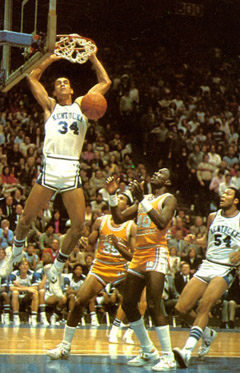 Kentucky's Kenny Walker (34) won numerous well deserved awards at UK.The 1986 SEC tournament MVP was not one of them
Kentucky's Kenny Walker (34) won numerous well deserved awards at UK.The 1986 SEC tournament MVP was not one of themThe 1986 SEC Tournament MVP was John Williams, of LSU. The mostly blue Kentucky crowd was shocked , expressing themselves in a variety of ways, as the Wildcat fans assumed it would come down to Harden or Walker and when Harden's name was called first, naturally Walker had to be the winner. Whereas Walker was certainly a candidate for the award and it was indeed a surprise he wasn't on the All-Tourney team at all, there was no denying Williams' credentials. Williams had 20 points and 20 rebounds in LSU's quarterfinal win over Florida. He also tallied 28 points and 12 rebounds in the semifinal loss to UK. Williams was the first and remains the only tourney MVP given to a player whose team didn't play in the championship game.
This was also the last SEC tournament final played on a Saturday. The following day on "Selection Sunday", four SEC teams were invited. Kentucky, the conference tournament winner and therefore conference representative was a one seed in the Southeast Regional and would face Davidson in the first round in Charlotte. They would be joined in Charlotte with Alabama ,the five seed who would face Xavier. Auburn was sent west as an 8 seed and would face Arizona and its coach Lute Olsen in Long Beach on the same court where Olsen led the 49ers to the 1974 Big West title.
The fourth of the four SEC teams was LSU. Not only did the Tigers make the tournament,but they were also placed in the Southeast Regional to play Purdue in Baton Rouge.The Tigers were a eleven seed one of the last 'at large' selections that year after Washington and DePaul, who were 12 seeds. The Boilermakers were a six seed,but even though they could wear the 'home colors' they would be the 'road team', something that certainly (with good reason) irritated Purdue coach Gene Keady as just two years ago they were a 3 seed in the 1984 MW regional in Memphis. Even though they received a first round bye,their first opponent would be Memphis State, on the Tigers' home court in Memphis. Now they'd be playing the LSU Tigers in Baton Rouge.
Kentucky and Alabama each advanced out of Charlotte and down I-85 to Atlanta's Omni. Kentucky waxed Davidson in the first round in a battle of "Wildcats". Davidson had reached its basketball zenith in the late 1960's reaching the Elite Eight in 1968 and 1969 losing in the East Regional Final Round both years to North Carolina. The Davidson Wildcats actually were ranked higher in the final regular season AP poll in '69 than the Kentucky Wildcats were. Lefty Driesell's Wildcats were ranked fifth and Adolph Rupp's Wildcats were seventh. Driesell soon left for Maryland to make the Terrapins "the UCLA of the East". Now Davidson was a sixteen seed in the East Regional. Kentucky won, 75-55.
 Lefty Driesell had some top ten teams at Davidson in '68 and '69,but they pulled up the rear at the #16 seed in the Southeast in 1986
Lefty Driesell had some top ten teams at Davidson in '68 and '69,but they pulled up the rear at the #16 seed in the Southeast in 1986Next up for Kentucky was Western Kentucky. The two schools located only 155 miles apart had only met once: in the 1971 NCAA Mideast Regional semifinal in Athens,Ga. Kentucky had avoided playing the Hilltoppers but couldn't avoid them in the tournament. Kentucky wished they had as Western gave Kentucky a humiliating 107-83 beatdown en route to the '71 Final Four. This time Kentucky won, 71-64.Western gave them a fight coming back from 16 down with under eleven minutes left to narrow the lead to 4 with under four minutes left before UK could salt the game away at the free throw line.
Fifth seeded Alabama easily disposed with Xavier 97-80 and met fourth seed Illinois from the Big 10.Alabama jumped out to an early 21-8 lead before the Illini took their first lead at 44-43 with 11:25 to go. After that it was back and forth until the final horn.After the Tide's Buck Johnson blocked an Efrem Winters' shot with :26 left and the game knotted at 56, Wimp Sanderson called time out.Point guard Terry Coner drove inside with :09 and unable to find an open teammate, pulled back and drained a twelve footer with :01 for the win. Illinois coach Lou Henson protested that Coner had walked but the Tide left Charlotte with a 58-56 win.
LSU's already crazy,colorful season was getting a second wind at home in Baton Rouge. 48 hours before LSU's game with six seed Purdue, the NCAA demanded clarification on Jose Vargas' amateur status. ESPN's Dick Vitale stated that LSU coach Dale Brown and his team said the team would boycott the Purdue game if Vargas was ruled ineligible. While athletic director Bob Brodhead denied this, the NCAA did indeed uphold Vargas' amateur status and he was cleared to play vs the Boliermakers.
LSU went on to win a 94-87 double overtime thriller over Purdue. While Purdue's Gene Keady's strategy to clamp down on super soph John Williams worked somewhat holding him to 16 points , four other Tigers scored in double figures with Anthony Wilson leading the way with a career high 25 (Vargas failed to score in only three minutes of action out of 50). However,Wilson was just getting started.
Next up was third seed Memphis State, the lone non Big East squad who had played in the 1985 Final Four. These Tigers stretched a 47-41 halftime lead to 10 with the first two baskets of the second half before the LSU Tigers went on a 9-1 run to cut the lead to six with under 11 minutes left and finally tied it at 73 after Ricky Blanton free throws and a John Williams layup following Baskerville Holmes' turnover. The game went back and forth for the rest of the game. Don Redden,playing his last game at LSU's Assembly Center scoring a team high 23 , missed a five foot shot with five seconds left.A mad dash ensued for the rebound with Williams,Wilson and Redden in hot pursuit. Wilson grabbed it, turned and released the ball as time expired. The ball hit the backboard ,bounced twice and fell in for a dramatic 83-81 LSU win as the Bengal Tigers went on to Atlanta to join SEC brethren Kentucky and Alabama as well as former SEC member Georgia Tech who had eliminated defending champion Villanova in the first game in Baton Rouge that day.
Meanwhile in out in Long Beach, Auburn brought back some up its tournament magic from the prior year. After beating Arizona 73-63 in the first round, Auburn destroyed one seed St John's and national player of the year, Walter Berry , 81-65 in the second round. Auburn's Chuck Person , feeling snubbed by being left off the All-America team in place of Berry and Maryland's Len Bias (also in Long Beach with his Terrapins facing UNLV) scored 27 points and 15 rebounds as a one man wrecking crew. Auburn led by 12 at halftime and continued on as St John's could only cut it to 8 one time in the second half. Auburn shot 53 percent from the floor and out-rebounded the Redmen 38-22 as they advanced on to the West Regional in Houston to face UNLV and Jerry Tarkanian, who like Arizona's Lute Olsen, also coached at Long Beach State.
Its often said during tournament time in particular situations that its "hard to be the same team three times in one season." Kentucky was about to find out how difficult it would be to defeat Alabama for the fourth time in one season. The 'Cats won both regular season games and the SEC tournament final not quite two weeks earlier. For Alabama, this was their third trip to the Sweet 16 in the last five seasons. Each time though, their season ended in the regional semifinal round. It would again this year as Kentucky won for an unprecedented fourth time over the same foe in one season this time 68-63. (Memphis State would join Alabama in 1992 with its fourth loss to Cincinnati.) The Tide played Kentucky tough trailing only by four at halftime and just two early in the second half at 38-36 after trailing by 12 late in the first half. But Kenny Walker and Winston Bennett were too much for Alabama's Buck Johnson's 16 in his last game of his superb Crimson Tide career and Terry Coner, the hero of the Illinois game and his team high 20 points. Now it was on to the Southeast Regional Final for a trip to the Final Four.
 Wimp Sanderson won lots of games at Alabama,but couldn't beat Kentucky in four tries in 1986
Wimp Sanderson won lots of games at Alabama,but couldn't beat Kentucky in four tries in 1986The other side of the SE bracket had fellow SEC foe LSU and hometown and down the street Georgia Tech. Georgia Tech ,of course , had been a charter member of the SEC in 1933 before leaving in 1965 in a regrettable decision on the Yellow Jackets part as they would be denied their request for re-admission in 1972. Tech played football and basketball as an independent until Georgia Tech joined the fledgling Metro Conference in 1975 as one of its charter members comprised of basketball schools located in large cities such as Tulane from New Orleans, Louisville and Memphis State. Tech then joined the Atlantic Coast Conference as a full member effective for the 1979-1980 season in football and basketball.
The ACC has always been known for its basketball and Tech was not ready for primetime. Tech went 1-27 in its first two years of league play which included an 0-14 mark in 1981.After the disastrous '81 season, rising star Bobby Cremins from Appalachian State was brought in to replace Dwane Morrison. The process under Cremins started slowly as the Yellow Jackets did improve their conference mark to 3-11 but still lanquished in the ACC cellar. In 1983 ,Tech finally got its first ACC tournament win and in 1984 completed their first winning season since 1979 (its final yr in the Metro) and went to the NIT. It all came togethor for Cremins and Georgia Tech in the 1984-1985 season. Tech tied for first in the ACC regular season and then won the ACC tournament title in the friendly confines of Atlanta's Omni over North Carolina giving Tech a three game sweep of the Tar Heels. Georgia Tech ,who stayed in the top 10 over the last six weeks of the regular season was eliminated in the East Regional final by Georgetown, who lost its chance to repeat as National Champion in Lexington a week later to Villanova in the title game.

Tech's Mark Price , Bruce Dalrymple and Coach Cremins talk to Billy Packer after winning the 1985 ACC title in Atlanta at the Omni,the site of the '86 SE Regional.
In 1985-1986, Tech was again looking at the title and this time ,it was the title. While an excellent team through the 1985 year, Tech had flown under the national radar until the ACC tourney title win.Now they were the choice by many preseason publications and polls to win the National Title in 1986. Cremins, an excellent ,national recruiter in addition to solid coach, had put togethor arguably the most talented starting five in the country entering that season. Mark Price, John Salley, Bruce Dalrymple , Tom Hammond and Duane Ferrell as a unit averaged nearly 70 points a game and each received numerous awards with each starter being named to either All-American,All-ACC or Freshman All-American squad of some publication.
Georgia Tech had a better conference record in '86 at 11-3 than they did the prior year at 9-5.However,they finished second to Duke who also won the ACC tourney title defeating Tech by one. Still, as they were seeded in '85, Tech was a two seed and won both its games in Baton Rouge in the first and second rounds. Now it was back down the street at the Omni ,the same court they won their first ACC title on a year earlier. A win over 11th seeded LSU and it was on to play Kentucky for a trip to Dallas for the Final Four. While the NCAA ceased allowing teams playing regionals on its home court two years earlier, it didn't prevent a team from playing in its home town. Tech couldn't have asked for anything more.
LSU after having lost ten straight post season tournament games of some variety,had now won 3 of 4. One over Florida in the SEC tourney in basically a de facto NCAA play-in game, and defeated six seed Purdue, and three seed Memphis State. The one loss was a squeaker to Kentucky in Lexington. LSU ,who started off 14-0 reaching number 8 in the polls ,and then went 7-10 until the SEC tournament had suddenly returned to its early season form playing excellent,confident basketball. This wouldn't be the typical "11" seed facing two seed Georgia Tech.
Dale Brown and Bobby Cremins had met once before. Their first NCAA tournament game was against one another in 1979 while Cremins was at Appalachian State which resulted in a 71-57 LSU win. Brown had taken his 1981 squad to the Final Four and was playing with house money now as his team which made the tournament by the skin of its teeth was a game away from a Regional final. Cremins and his team had tremendously high expectations from the first game of the season and after a regional final the year before, just making the Sweet 16 wasn't going to be good enough.
LSU's dream season continued and Tech's dreams died that evening. In a tight , defensive struggle where neither team led by more than six, LSU won 70-64. The Tigers led 36-30 at halftime. But Tech All-American Mark Price, playing what turned out to be his last game for Georgia Tech kept Tech in the game with 20 points and made two straight jump shots to give Georgia Tech its biggest lead of the night at 56-52 with 6:20 left in the game. LSU had been down and out at times all season. This was nothing. Behind seniors Don Redden and Derrick Taylor , LSU went on a 10-2 run to go up 62-58 with 2:37 left as LSU's defense got them back in the game with Brown's unconvential "freak defense". Oliver Brown chased Price all over the court after Tech's brief 4 pt lead. With LSU clinging to a 64-60 lead, Dalrymple was unable to find Price open and was called for charging on a drive to the hoop. Ricky Blanton then made an contested layup to salt it away at 66-60 with :51 left.
While not on their home court, LSU had defeated Georgia Tech in its hometown to advance to the regional final against Kentucky. Georgia Tech's hometown paper the Atlanta Journal-Constitution was so confident of a Yellow Jacket win that in prepartion for the next day's paper and having to face a late night deadline, Georgia Tech's name was type set on the top of the front page in the slot reserved for the victorious team. Unlike the features used on television or a baseball scoreboard where the visiting team is listed on top, a newspaper list the winning team on top when scores are printed on the top of front pages of newspapers. Kentucky's win over Alabama was noted as normal:
Kentucky 68
Alabama 63
Next to that was the LSU-Georgia Tech score:
Georgia Tech 64
LSU 70
Meanwhile , Auburn was the lone SEC team in the West regional. Auburn won its first two games ever in the NCAA the prior year and a win vs UNLV would take them a game further than before. But the Runnin' Rebels almost ran Auburn out of Houston's Summit in the first half three times taking 14 point leads and taking a 34-25 lead into intermission.
Auburn was a more physical team than UNLV and that worked to Auburn's advantage in the second half. Behind Chuck Person, Auburn started chipping away sometimes getting two and three shots at the goal and outrebounded UNLV by 12 in the second half. Auburn took its first lead since 2-0 at 50-49 with 7:49 left on a Jeff Moore basket. Auburn took the lead for good at 56-55 with 3:55 left to pull out a 70-63 win over the Rebels, who were led by Armon Gilliam's 21 and Freddie Banks' 20 points. Two years ago Auburn lost its first ever NCAA tourney game to Richmond. Now they were facing Louisville in the West Regional Final.
Regional finals were old hat for Louisville. Since Denny Crum arrived in the fall of 1971, the Cardinals had made five Final Fours winning it all in 1980. But Villanova seemed to have come out of nowhere as an 8 seed the previous season to win the title,so Auburn could,too.
And Auburn played one of its best games all season . Unfortunately, so did Louisville. Auburn continued its second half play vs UNLV into the first half of the Louisville game. Auburn shot 62% in the first half and outrebounded the Cardinals. Still, Louisville shot 56% and took a 44-43 lead into halftime of the racehorse game. Against the advice of his assistant coaches, Crum had the Cards stay in a man to man defense. But with ten minutes to go,he relented and briefly went to a zone that was keyed around Chuck Person. Pervis Ellison ,who scored 15 points helped shut down Person on defense with some help from Milt Wagner forcing the Tigers to shoot from the outside where they started to cool off. Ellison completed a three point play with 8:42 to put Louisville up for good at 68-67. Louisville slowly stretched the lead out some as they held off Auburn. The Cardinals won 84-76 sending them to their fourth Final Four of the 1980's. Person finished the game and his Auburn career with 23 points and was named West Regional MVP.
 Auburn's Chuck Person was name MVP of the 1986 West Regional
Auburn's Chuck Person was name MVP of the 1986 West RegionalWhereas Houston's Summit wasn't quite 60% full for the West title game, the Omni in Atlanta was busting at the seams with more than 16,000 with more outside wanting to get in for Round 4 of LSU-Kentucky, the second time in two days UK would face a conference foe for the fourth time. Kentucky wasted little time taking an 11-4 lead four minutes into the game. But LSU knotted it up at 14 and took its first lead at 17-16 on a John Williams free throw with under twelve minutes to go in the half. The game would be a see-saw affair until the final horn. Kenny Walker gave Kentucky a 34-33 halftime lead on an eight foot shot at the buzzer.
LSU struck first out of the lockerroom to go back on top, 35-34. Four lead changes and three ties later, the teams were even at 43 with ten minutes left. UK went on a 4-0 "run",but after an LSU timeout, the Tigers even things once again at 47. LSU went up for good on two Ricky Blanton free throws with 2:31 left.
Ahead 57-55 with :44 left, LSU went to a spread office thinking Kentucky would quickly foul. Sutton and Kentucky tried to steal the ball instead. Don Redden was able to find Blanton alone for a layup with :17 to put LSU up 59-55 (the last season before the three point shot). LSU's old friend Roger Harden made a layup to cut it to 59-57. John Williams then missed two free throws and then UK's James Blackmon missed on a 65 footer as time expired for a 59-57 LSU win and a trip to Dallas for the Final Four.
 To paraphrase Vin Scully, in defeating Kentucky for the right to go to the Final Four,in a year that had been so improbable, the impossible happened, as Derrick Taylor (l) and Anthony Wilson celebrate the 59-57 win
To paraphrase Vin Scully, in defeating Kentucky for the right to go to the Final Four,in a year that had been so improbable, the impossible happened, as Derrick Taylor (l) and Anthony Wilson celebrate the 59-57 winWith no one expecting much from them, LSU played inspired and loose the whole game while Kentucky seemed to feel the pressure from being a one seed and needing to dispose of the same team again for the seemingly umpteenth time.
 LSU, with the late Don Redden, joined Duke , Kansas and its opponent in the National Semifinal, Louisville in the 1986 Final Four in Dallas
LSU, with the late Don Redden, joined Duke , Kansas and its opponent in the National Semifinal, Louisville in the 1986 Final Four in Dallas 




 #9 Seed Penn upset #1 seed North Carolina in the second round proving that the new tournament seeding wasn't an exact science. Penn's Tony Price is shown here scoring a layup over North Carolina's Dudley Bradley (22) , or Bradley Dudley as NBC analyst Al McGuire called him,and Al Wood in the Quakers' stunning 72-71 upset in March 1979
#9 Seed Penn upset #1 seed North Carolina in the second round proving that the new tournament seeding wasn't an exact science. Penn's Tony Price is shown here scoring a layup over North Carolina's Dudley Bradley (22) , or Bradley Dudley as NBC analyst Al McGuire called him,and Al Wood in the Quakers' stunning 72-71 upset in March 1979 Tennessee was eliminated by Bernard King's little brother, Albert(scoring over UT's Reggie Johnson) and Maryland in the second round of the 1980 NCAA tournament. Still,after going
Tennessee was eliminated by Bernard King's little brother, Albert(scoring over UT's Reggie Johnson) and Maryland in the second round of the 1980 NCAA tournament. Still,after going 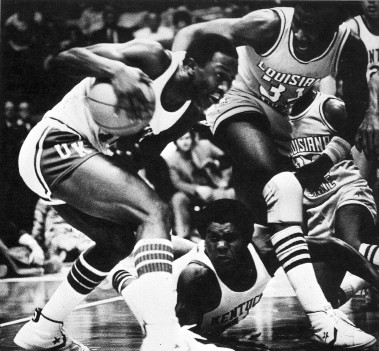
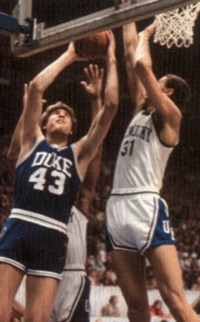 Mike
Mike  Darrell Griffith, "Doctor of Dunk" was too much for
Darrell Griffith, "Doctor of Dunk" was too much for  After losing to Indiana State and Larry Bird in '79 in the 1979 Final Four as a two seed in the first year of seeding,
After losing to Indiana State and Larry Bird in '79 in the 1979 Final Four as a two seed in the first year of seeding,  Sonny Smith (middle), Head Coach Don
Sonny Smith (middle), Head Coach Don  Chuck Person was named after "the Rifleman" who is one of 12 men to have played in the NBA and Major League Baseball.
Chuck Person was named after "the Rifleman" who is one of 12 men to have played in the NBA and Major League Baseball.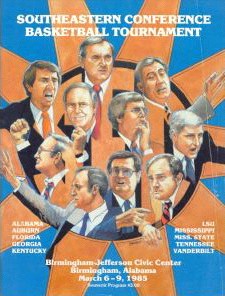 Game program for the 1985 SEC Basketball Tournament
Game program for the 1985 SEC Basketball Tournament

 Like Pat Dye, Auburn's Ralph 'Shug' Jordan was Auburn head football coach and athletic director.Unlike Dye, Jordan spent ten years as Auburn's basketball coach.
Like Pat Dye, Auburn's Ralph 'Shug' Jordan was Auburn head football coach and athletic director.Unlike Dye, Jordan spent ten years as Auburn's basketball coach.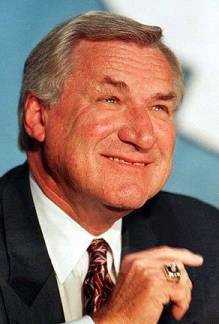 Advancing to the Sweet 16, or "Regionals" was business as usual for this Coach Smith.
Advancing to the Sweet 16, or "Regionals" was business as usual for this Coach Smith. Neither Vandy nor Alabama were ranked as high in '74 as Ethel and "The Streak"
Neither Vandy nor Alabama were ranked as high in '74 as Ethel and "The Streak" 1973-1974 SEC Champion Vanderbilt Commodores
1973-1974 SEC Champion Vanderbilt Commodores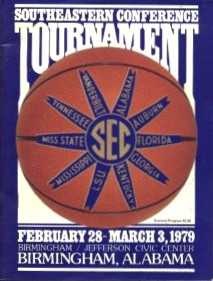 Game program for the first SEC Basketball Tournament since 1952
Game program for the first SEC Basketball Tournament since 1952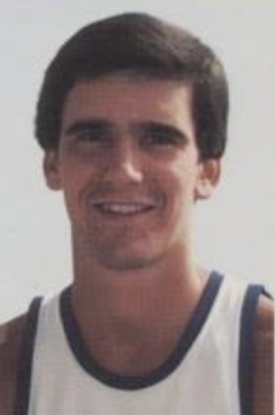
 Pro Wrestler Kevin Nash played for the 1979 SEC Tourney Champion Tennessee Vols
Pro Wrestler Kevin Nash played for the 1979 SEC Tourney Champion Tennessee Vols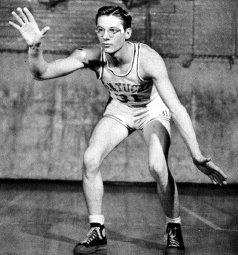
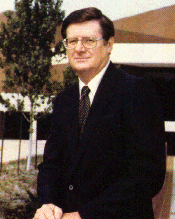
 Hugh Durham took Florida State to the Final Four in 1972 as well as with Georgia in 1983
Hugh Durham took Florida State to the Final Four in 1972 as well as with Georgia in 1983